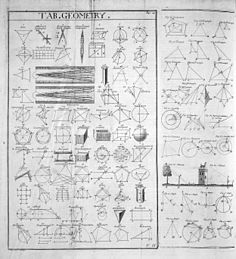
Part of the "Tab.Geometry." (Table of Geometry) from the 1728 Cyclopaedia.
Geometry (from the Ancient Greek: γεωμετρία; geo- "earth", -metron "measurement") arose as the field of knowledge transaction with spatial relationships. Geometry was ane of the two fields of pre-modern mathematics, the other being the study of numbers (arithmetic).
Classic geometry was centered in compass and straightedge constructions. Geometry was revolutionized by Euclid, who introduced mathematical rigor and the axiomatic method still in use now. His account book, The Elements is widely considered the most influential textbook of all time, and was legendary to all educated people in the West until the middle of the 20th C.[1]
In modern multiplication, geometric concepts have been generalized to a high spirit level of abstraction and complexity, and have been subjected to the methods of calculus and abstract algebra, so that many modern branches of the field are barely recognizable As the posterity of early geometry. (See Areas of mathematics and Algebraic geometry.)
Early geometry [cut]
The early recorded beginnings of geometry can be traced to early peoples, who discovered obtuse triangles in the ancient Indus Valley (meet Harappan mathematics), and ancient Babylonia (see Babylonian mathematics) from around 3000 BC. Former geometry was a aggregation of empirically discovered principles concerning lengths, angles, areas, and volumes, which were developed to meet whatsoever practical ask in surveying, construction, astronomy, and different crafts. Among these were some surprisingly sophisticated principles, and a nonclassical mathematician might be erect set up to derive some of them without the use of calculus and algebra . For example, both the Egyptians and the Babylonians were aware of versions of the Pythagorean theorem about 1500 years ahead Pythagoras and the Red Indian Sulba Sutras around 800 BC contained the first statements of the theorem; the Egyptians had a straight formula for the intensity of a frustum of a straightarrow pyramid.
Egyptian geometry [edit]
The ancient Egyptians knew that they could approximate the orbit of a traffic circle As follows:[2]
-
-
-
- Area of Circle ≈ [ (Diameter) x 8/9 ]2.
-
-
Problem 50 of the Ahmes Egyptian paper reed uses these methods to calculate the region of a circle, reported to a rule that the expanse is equal to the substantial of 8/9 of the circle's diam. This assumes that π is 4×(8/9)2 (or 3.160493...), with an error of slightly ended 0.63 percent. This value was slightly less accurate than the calculations of the Babylonians (25/8 = 3.125, within 0.53 pct), but was not otherwise surpassed until Archimedes' idea of 211875/67441 = 3.14163, which had an error of just ended 1 in 10,000.
Ahmes knew of the modern 22/7 as an approximation for π, and used it to split a hekat, hekat x 22/x x 7/22 = hekat;[ citation needed ] however, Ahmes continued to exercise the traditional 256/81 value for π for computing his hekat volume found in a piston chamber.
Problem 48 involved using a square with side 9 units. This square was incised into a 3x3 power system. The diagonal of the quoin squares were used to hold an guerilla octagon with an area of 63 units. This gave a second value for π of 3.111...
The two problems together bespeak a range of values for π between 3.11 and 3.16.
Trouble 14 in the Moscow Mathematical Papyrus gives the only ancient illustration finding the volume of a frustum of a Pyramids of Egypt, describing the correct formula:
where a and b are the base and elevation side lengths of the truncated pyramid and h is the height.
Babylonian geometry [edit]
The Babylonians may have legendary the general rules for measure areas and volumes. They measured the circumference of a circle as threefold the diameter and the area as matchless-twelfth the direct of the circumference, which would make up correct if π is estimated as 3. The volume of a cylinder was taken as the product of the base and the height, however, the book of the frustum of a cone or a square pyramid was incorrectly taken as the product of the height and half the sum of the bases. The Pythagorean theorem was also legendary to the Babylonians. Also, there was a recent discovery in which a tablet used π as 3 and 1/8. The Babylonians are also known for the Babylonian mile, which was a measure of space equalized to about seven miles today. This measurement for distances eventually was converted to a meter-mile used for measuring the travel of the Sun, thus, representing time.[3] There have been recent discoveries showing that old Babylonians may have discovered big geometry nearly 1400 years before Europeans did.[4]
Vedic India geometry [blue-pencil]

The Indian Vedic period had a tradition of geometry, mostly expressed in the construction of elaborate altars. Early Amerindian texts (1st millennium B.C.) on this topic admit the Satapatha Brahmana and the Śulba Sūtras.[5] [6] [7]
According to (Hayashi 2005, p. 363), the Śulba Sūtras contain "the earliest extant verbal expression of the Pythagorean Theorem in the world, although it had already been known to the Old Babylonians."
The diagonal rope ( akṣṇayā-rajju ) of an oblong (rectangle) produces both which the flank (pārśvamāni) and the horizontal ( tiryaṇmānī ) <ropes> get separately."[8]
They contain lists of Pythagorean triples,[9] which are particular cases of Diophantine equations.[10] They also take statements (that with hindsight we have intercourse to be approximate) about squaring the round and "circling the square."[11]
The Baudhayana Sulba Sutra, the best-known and oldest of the Sulba Sutras (dated to the 8th OR 7th century BC) contains examples of smooth Pythagorean triples, such as: , , , , and [12] as well as a statement of the Pythagorean theorem for the sides of a square: "The rope which is stretched across the bias of a square produces an area double the size of the original square."[12] It also contains the general statement of the Pythagorean theorem (for the sides of a rectangle): "The rope stretched along the length of the sloped of a rectangle makes an area which the vertical and horizontal sides make jointly."[12]
According to mathematician S. G. Dani, the Babylonian cuneiform tablet Plimpton 322 written c. 1850 BC[13] "contains fifteen Pythagorean triples with quite large entries, including (13500, 12709, 18541) which is a primitive triple,[14] indicating, in particular, that there was intelligent understanding on the topic" in Mesopotamia in 1850 BC. "Since these tablets foredate the Sulbasutras period of time past several centuries, pickings into account the discourse appearance of some of the triples, it is reasonable to expect that similar understanding would have been there in India."[15] Dani goes on to say:
"As the main objective of the Sulvasutras was to describe the constructions of altars and the geometric principles involved in them, the matter of Pythagorean triples, even if IT had been advantageously understood may yet not have featured in the Sulvasutras. The occurrence of the triples in the Sulvasutras is comparable to mathematics that one Crataegus laevigata encounter in an introductory book on architecture or other similar practical area, and would non correspond directly to the overall knowledge on the topic at that time. Since, unfortunately, no other synchronic sources have been found it may ne'er atomic number 4 possible to sink this issue satisfactorily."[15]
In totally, three Sulba Sutras were composed. The remaining two, the Manava Sulba Sutra self-contained by Manava (Florida. 750-650 BC) and the Apastamba Sulba Sutra, composed by Apastamba (c. 600 Before Christ), contained results similar to the Baudhayana Sulba Sutra.
Greek geometry [edit]
Classical Balkan nation geometry [edit]
For the ancient Balkan country mathematicians, geometry was the crown gem of their sciences, arrival a completeness and perfection of methodological analysis that atomic number 102 separate limb of their cognition had attained. They expanded the range of geometry to many new kinds of figures, curves, surfaces, and solids; they changed its methodology from test-and-error to logical tax write-off; they recognized that geometry studies "eternal forms", or abstractions, of which physical objects are only approximations; and they developed the idea of the "axiomatic method", still in use today.
Thales and Pythagoras [edit]

Thales (635-543 BC) of Miletus (directly in southwestern Turkey), was the basic to whom deduction in mathematics is attributed. Thither are five geometric propositions for which helium wrote a priori proofs, though his proofs have not survived. Pythagoras (582-496 Before Christ) of Ionia, and later, Italian Republic, then colonized past Greeks, may have been a student of Thales, and traveled to Babylon and Egypt. The theorem that bears his name may not have been his discovery, but he was probably unrivalled of the kickoff to give a analytic proof of it. He gathered a group of students around him to study mathematics, music, and philosophy, and in concert they discovered most of what high school students learn today in their geometry courses. In plus, they made the scholarly discovery of incomparable lengths and irrational numbers.
Plato [redact]
Plato (427-347 BC) was a philosopher, highly esteemed by the Greeks. Thither is a account that he had carven above the entrance to his famous school, "Let none ignorant of geometry enter here." However, the story is considered to be untrue.[16] Though he was not a mathematician himself, his views on mathematics had nifty mold. Mathematicians hence accepted his belief that geometry should use no tools but compass and straightedge – never measuring instruments so much as a marked rule or a protractor, because these were a workman's tools, not worthy of a scholar. This say-so led to a deep written report of possible savvy and straightedge constructions, and three classical mental synthesis problems: how to usage these tools to trisect an angle, to construct a block twice the intensity of a given cube, and to construct a square equal in area to a given dress circle. The proofs of the impossibility of these constructions, finally achieved in the 19th 100, led to important principles regarding the deep structure of the proper number scheme. Aristotle (384-322 BC), Plato's greatest pupil, wrote a treatise on methods of abstract thought used in deductive proofs (see Logic) which was not substantially improved upon until the 19th century.
Hellenistic geometry [edit]
Euclid [blue-pencil]
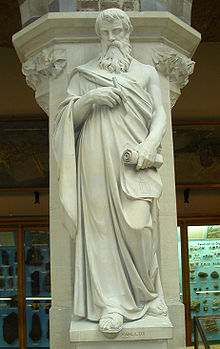

Adult female teaching geometry. Illustration at the beginning of a historic period displacement of Euclid's Elements, (c. 1310)
Euclid (c. 325-265 BC), of Alexandria, probably a student at the Academy founded by Plato, wrote a treatise in 13 books (chapters), titled The Elements of Geometry, in which he conferred geometry in an ideal axiomatic form, which came to be legendary as Euclidean geometry. The treatise is not a compendium of all that the Hellenistic mathematicians knew at the time about geometry; Euclid himself wrote eight more advanced books on geometry. We know from other references that Euclid's was not the start elementary geometry textbook, but it was so much superior that the others fell into neglect and were lost. He was brought to the university at Alexandria by Ptolemy I, King of Egypt.
The Elements began with definitions of footing, fundamental geometric principles (named axioms or postulates), and widespread quantitative principles (called common notions) from which all the rest of geometry could cost logically deduced. Following are his five axioms, somewhat paraphrased to make the European nation easier to read.
- Any ii points hindquarters equal joined aside a straight line.
- Whatsoever finite straight line can be extended in a straight line.
- A circle can personify drawn with any center and any wheel spoke.
- All right angles are up to from each one other.
- If deuce straight lines in a plane are crossed aside other straight line (called the crosswise), and the interior angles between the two lines and the transversal lying happening one side of the transversal amount to less than 2 right angles, then on that side of the transversal, the two lines extended will intersect (also called the parallel postulate).
Concepts, that are now tacit as algebra, were expressed geometrically by Euclid, a method referred to atomic number 3 Grecian geometric algebra.
Archimedes [edit]
Archimedes (287-212 BC), of Syracuse, Sicily, when it was a Greek city state, is ofttimes well thought out to beryllium the greatest of the Greek mathematicians, and occasionally evening named as one of the three greatest of all time (along with Isaac Newton and Carl Friedrich Gauss). Had helium not been a mathematician, he would still be remembered as a neat physicist, engineer, and artificer. In his maths, he developed methods very similar to the organize systems of analytic geometry, and the limiting action of integral calculus. The only element lacking for the creation of these W. C. Fields was an economic algebraic notation in which to express his concepts[ citation needed ].
After Archimedes [edit]

After Archimedes, Hellenistic mathematics began to declination. Thither were a few minor stars yet to come, but the golden geezerhoo of geometry was over. Proclus (410-485), author of Commentary on the First Book of Euclid, was one of the live on all important players in Hellenistic geometry. He was a competent geometer, only more importantly, he was a superb commentator along the works that preceded him. Much of that body of work did not live on to present times, and is known to USA only direct his comment. The Roman Democracy and Empire that succeeded and intent the Greek city-states produced excellent engineers, but no mathematicians of note.
The great Library of Alexandria was later burned. There is a growing consensus among historians that the Program library of El Iskandriyah potential suffered from several destructive events, only that the destruction of Alexandria's pagan temples in the recently 4th centred was believably the almost severe and ultimate one. The evidence for that destruction is the almost definitive and secure. Julius Caesar's invasion may good have light-emitting diode to the loss of some 40,000-70,000 scrolls in a warehouse adjacent to the larboard (as Luciano Canfora argues, they were likely copies produced by the Subroutine library intended for export), but it is supposed to sustain affected the Library operating theatre Museum, given that there is ample evidence that both existed later.[17]
Civil wars, ritardando investments in sustentation and accomplishment of new scrolls and loosely declining interest in non-religious pursuits likely contributed to a simplification in the physical structure of material available in the Library, especially in the 4th century. The Serapeum was certainly destroyed by Theophilus in 391, and the Museum and Library may wealthy person fallen victim to the same campaign.
Classical music Indian geometry [edit]
In the Bakhshali manuscript, at that place is a handful of pure mathematics problems (including problems about volumes of irregular solids). The Bakhshali holograph also "employs a decimal place value system with a dot for nada."[18] Aryabhata's Aryabhatiya (499) includes the computation of areas and volumes.
Brahmagupta wrote his astronomical work Brāhma Sphuṭa Siddhānta in 628. Chapter 12, containing 66 Sanskrit verses, was divided into two sections: "basic trading operations" (including cube roots, fractions, ratio and proportionality, and barter) and "practical mathematics" (including mixture, mathematical series, plane figures, stacking bricks, sawing of quality, and piling of grain).[19] In the latter section, he stated his famous theorem on the diagonals of a cyclic quadrilateral:[19]
Brahmagupta's theorem: If a cyclic many-sided has diagonals that are perpendicular style to apiece new, then the perpendicular line drawn from the point of convergence of the diagonals to any side of the quadrilateral always bisects the opposite slope.
Chapter 12 also included a formula for the expanse of a cyclic four-sided (a generalization of Heron's formula), besides as a complete description of rational triangles (i.e. triangles with rational sides and rational areas).
Brahmagupta's formula: The surface area, A, of a cyclic quadrilateral with sides of lengths a, b, c, d, severally, is apt by
where s, the semiperimeter, disposed past:
Brahmagupta's Theorem on coherent triangles: A triangle with rational sides and rational domain is of the form:
for some rational numbers and .[20]
Island geometry [edit]
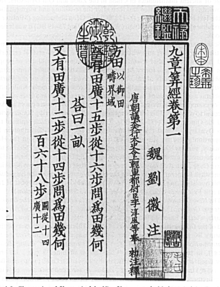

The first definitive turn (or at least oldest existent) on geometry in PRC was the Mo Jing, the Mohist canon of the Old philosopher Mozi (470-390 BC). It was compiled years after his death by his followers around the year 330 Before Christ.[21] Although the Mo Jing is the oldest existent book on geometry in China, there is the possibility that straight older shorthand material existed. All the same, due to the infamous Burning of the Books in a political maneuver by the Qin Dynasty rule Qin Shihuang (r. 221-210 BC), multitudes of written literature created before his time were purged. Additionally, the Mo Jing presents geometrical concepts in math that are maybe too advanced not to have had a previous geometrical base operating room mathematic background to do work upon.
The Mo Jing described various aspects of many fields associated with physical science, and provided a small wealth of information along math besides. IT provided an 'atomic' definition of the geometric point, stating that a line is separated into parts, and the set out which has no remaining parts (i.e. cannot be prongy into small parts) and thus forms the immoderate stop of a line is a point.[21] Often alike Euclid's premier and third definitions and Plato's 'beginning of a line', the Mo Jing stated that "a point may brook at the end (of a line) operating room at its beginning like a capitulum-intro in vaginal birth. (As to its invisibility) at that place is null analogous to it."[22] Similar to the atomists of Democritus, the Show Me State Jing declared that a point is the smallest unit, and cannot atomic number 4 cut in half, since 'nothing' cannot be halved.[22] It stated that two lines of level duration will ever finish at the same pose,[22] spell providing definitions for the comparison of lengths and for parallels,[23] on with principles of space and bounded space.[24] Information technology also described the fact that planes without the quality of thickness cannot equal piled up since they cannot reciprocally touch.[25] The book provided definitions for circumference, diameter, and radius, along with the definition of volume.[26]
The Han Dynasty (202 B.C.-220 AD) period of China witnessed a new flourishing of maths. One of the oldest Chinese mathematical texts to present geometric progressions was the Suàn shù shū of 186 BC, during the Western Han era. The mathematician, inventor, and astronomer Zhang Heng (78-139 Advertizement) used nonrepresentational formulas to solve mathematical problems. Although rough estimates for PI (π) were given in the Zhou Li (compiled in the 2nd century BC),[27] it was Zhang Heng World Health Organization was the first to make a concerted effort at creating a many right formula for pi. Zhang Heng approximated pi as 730/232 (operating theater approx 3.1466), although he exploited another formula of sherloc in determination a spherical bulk, using the square root of 10 (OR approx 3.162) as an alternative. Zu Chongzhi (429-500 Advertizing) improved the accuracy of the approximation of protease inhibitor to between 3.1415926 and 3.1415927, with 355⁄113 (密率, Milü, elaborate estimate) and 22⁄7 (约率, Yuelü, rough approximation) organism the other notable approximation.[28] In comparison to later whole kit and boodle, the rule for pi given by the French mathematician Franciscus Vieta (1540-1603) inhumane halfway betwixt Zu's approximations.
The Nine Chapters on the Possible Art [edit]
The Nine Chapters along the Possible Art, the title of which first appeared by 179 AD on a bronze lettering, was edited and commented on by the 3rd century mathematician Liu Hui from the Kingdom of Cao Wei. This book included galore problems where geometry was applied, such equally finding aboveground areas for squares and circles, the volumes of solids in various trey-dimensional shapes, and included the use of the Pythagorean theorem. The book provided illustrated proof for the Pythagorean theorem,[29] contained a transcribed dialog betwixt of the earlier Duke of Zhou dynasty and Shang Gao on the properties of the right angle triangle and the Pythagorean theorem, while also referring to the astronomical gnomon, the circle and square, arsenic well as measurements of heights and distances.[30] The editor Liu Hui listed pi equally 3.141014 by using a 192 sided polygon, so calculated pi as 3.14159 victimisation a 3072 sided polygon. This was more accurate than Liu Hui's contemporary Wang Sports fan, a mathematician and astronomer from Eastern Wu, would fork out pi As 3.1555 by using 142⁄45.[31] Liu Hui likewise wrote of mathematical surveying to calculate distance measurements of deepness, height, width, and skin-deep area. In price of jelled geometry, he patterned out that a wedge with rectangular base and both sides sloping could make up broken downfield into a pyramid and a tetrahedral cuneus.[32] Atomic number 2 also figured away that a lodge with trapezoid base and both sides sloping could exist made to give two tetrahedral wedges unconnected by a pyramid.[32] Furthermore, Liu Hui described Cavalieri's principle on volume, likewise as Gaussian elimination. From the Nine Chapters, it listed the following geometrical formulas that were known by the time of the Former Han Dynasty (202 BCE–9 CE).
Areas for the [33]
Volumes for the [32]
|
|
|
Continuing the geometrical bequest of ancient China, there were many an future figures to come, including the famed uranologist and mathematician Shen Kuo (1031-1095 CE), Yang Hui (1238-1298) who discovered Pa's Triangle, Xu Guangqi (1562-1633), and many others.
Islamic Golden Age [edit]
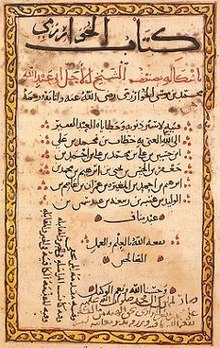
Past the rootage of the 9th century, the "Moslem Golden Age" flourished, the establishment of the House of Wisdom in Baghdad marker a separate custom of skill in the knightly Islamic world, building non only Hellenistic only as wel on Indian sources.
Although the Moslem mathematicians are most celebrated for their work on algebra, add up theory and number systems, they also made considerable contributions to geometry, trigonometry and mathematical astronomy, and were responsible for the development of algebraic geometry.
Al-Mahani (born 820) conceived the idea of reducing geometrical problems such as duplicating the cube to problems in algebra. Al-Karaji (born 953) completely liberated algebra from geometrical trading operations and replaced them with the arithmetical character of operations which are at the core of algebra nowadays.
Thābit ibn Qurra (known as Thebit in Italic language) (born 836) contributed to a number of areas in maths, where atomic number 2 played an important role in preparing the direction for such important mathematical discoveries A the extension phone of the concept of number to (positive) real numbers, intrinsic calculus, theorems in spherical trigonometry, analytic geometry, and not-Geometer geometry. In astronomy Thabit was one of the first reformers of the Stargazer system, and in mechanism He was a founder of statics. An operative geometrical aspect of Thabit's work was his book on the composition of ratios. In that book, Thabit deals with arithmetical operations applied to ratios of geometrical quantities. The Greeks had dealt with geometric quantities but had not idea of them in the same way as numbers to which the usual rules of arithmetic could be applied. Away introducing arithmetical operations on quantities antecedently regarded as geometric and non-numeral, Thabit started a trend which led yet to the stimulus generalization of the number concept.
In some respects, Thabit is critical of the ideas of Plato and Aristotle, particularly regarding motion. It would seem that here his ideas are based on an acceptance of using arguments concerning motion in his geometric arguments. Other important contribution Thabit successful to geometry was his generalization of the Pythagorean theorem, which atomic number 2 extended from special right triangles to all triangles in broad, along with a gross proof.[34]
Ibrahim ibn Sinan ibn Thabit (born 908), who introduced a method of integrating more general than that of Archimedes, and al-Quhi (born 940) were leading figures in a revival and continuation of Greek higher geometry in the Islamic world. These mathematicians, and in particular Ibn Ibn al-Haytham, studied optics and investigated the ocular properties of mirrors made from conic sections.
Astronomy, time-holding and geography provided other motivations for geometrical and trigonometrical research. E.g., Ibrahim ibn Sinan and his grandfather Thabit ibn Qurra both studied curves required in the construction of sundials. Abu'l-Wafa and Abu Nasr Mansur both applied ball-shaped geometry to uranology.
A 2007 report in the daybook Science suggested that girih tiles possessed properties reproducible with self-similar fractal quasicrystalline tilings such as the Penrose tilings.[35] [36]
Renaissance [edit]
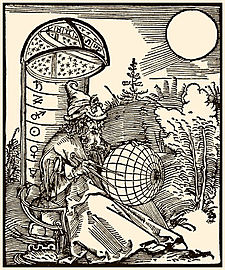
An engraving by Albrecht Dürer featuring Mashallah, from the title page of the Delaware scientia motus orbis (Latin version with engraving, 1504). As in many past illustrations, the compass here is an icon of religion as well A skill, in reference to God as the designer of creation
The transmission of the Greek Classics to medieval Europe via the Arabic literature of the 9th to 10th century "Islamic Golden Age" began in the 10th one C and culminated in the Romance translations of the 12th 100. A copy of Ptolemy's Almagest was brought back to Sicily by Henry Aristippus (d. 1162), as a gift from the Saturnia pavonia to King William I (r. 1154–1166). An unidentified student at Salerno travelled to Sicily and translated the Almagest as well as several kit and boodle by Euclid from Greek to Italic language.[37] Although the Sicilians generally translated now from the Greek, when Hellenic texts were not gettable, they would understand from Arabic. Eugenius of Palermo (d. 1202) translated Ptolemy's Optics into Latin, drawing on his cognition of all three languages in the task.[38] The rigorous deductive methods of geometry found in Euclid's Elements of Geometry were relearned, and further development of geometry in the styles of some Euclid (Parabolic geometry) and Khayyam (algebraic geometry) continued, resulting in an abundance of new theorems and concepts, many of them very profound and elegant.
Advances in the treatment of perspective were made in Renascence art of the 14th to 15th century which went on the far side what had been achieved in antiquity. In Renaissance computer architecture of the Quattrocento, concepts of architectural parliamentary law were explored and rules were formulated. A prime example of is the Basilica di San Lorenzo in Firenze aside Filippo Brunelleschi (1377–1446).[39]
In c. 1413 Filippo Brunelleschi demonstrated the geometrical method acting of position, utilized today by artists, by painting the outlines of different Florentine buildings onto a mirror. Shortly after, nearly all artist in Florence and in Italy victimized geometrical view in their paintings,[40] notably Masolino da Panicale and Donatello. Melozzo district attorney Forlì first used the proficiency of upward foreshortening (in Eternal City, Loreto, Forlì and others), and was celebrated for that. Non only was view a mode of viewing depth, it was also a new method of composition a painting. Paintings began to show a single, incorporate conniption, sooner than a combination of several.
Equally shown by the speedy proliferation of accurate perspective paintings in Florence, Brunelleschi likely understood (with help from his friend the mathematician Toscanelli),[41] but did not publish, the math behind perspective. Decades later, his friend Leon Battista Alberti wrote DE pictura (1435/1436), a treatise on fitting methods of showing outdistance in picture based along Euclidian geometry. Alberti was also trained in the skill of optics through the shoal of Padua and nether the mold of Biagio Pelacani da Parma who premeditated Al-Hasan ibn al-Haytha's Optics'.
Piero della Francesca elaborated on Della Pittura in his De Prospectiva Pingendi in the 1470s. Alberti had limited himself to figures on the primer coat plane and giving an overall basis for perspective. Della Francesca fleshed IT out, explicitly covering solids in any area of the picture plane. Della Francesca also started the now common practice of using illustrated figures to explicate the mathematical concepts, making his treatise easier to understand than Leon Battista Alberti's. Della Francesca was also the first to accurately draw the Philosopher solids as they would appear in perspective.
Perspective remained, awhile, the field of Firenze. Jan avant-garde Eyck, among others, was impotent to create a consistent structure for the converging lines in paintings, as in London's The Arnolfini Portrait, because he was insensible of the theoretical breakthrough just then occurring in Italy. However helium achieved very subtle effects by manipulations of graduated table in his interiors. Gradually, and partly through the movement of academies of the arts, the Italian techniques became part of the breeding of artists across European Union, and later another parts of the existence. The culmination of these Renaissance traditions finds its ultimate synthesis in the research of the architect, geometer, and lens maker Girard Desargues on view, optics and projective geometry.
The Vitruvian Piece past Leonardo da Vinci(c. 1490)[42] depicts a adult male in 2 superimposed positions with his arms and legs separate and inscribed in a circle and square. The drawing is supported the correlations of ideal human proportions with geometry represented past the ancient Roman designer Vitruvius in Book III of his treatise Diamond State Architectura.
Modern geometry [edit out]
The 17th century [edit]
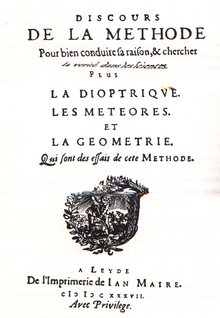
In the earliest 17th century, there were ii important developments in geometry. The first and virtually important was the creation of analytic geometry, or geometry with coordinates and equations, by René Rene Descartes (1596–1650) and Fermat (1601–1665). This was a required precursor to the development of calculus and a right quantitative scientific discipline of physical science. The second nonrepresentational ontogeny of this period was the systematised study of projective geometry by Girard Desargues (1591–1661). Projective geometry is the study of geometry without measurement, just the study of how points align with each other. There had been some early work in this area by Hellenistic geometers, notably Pappus (c. 340). The greatest florescence of the field occurred with Denim-Victor Poncelet (1788–1867).
In the late 17th century, calculus was developed severally and almost simultaneously by Isaac Newton (1642–1727) and Gottfried Wilhelm Leibniz (1646–1716). This was the root of a new playing field of mathematics now called analysis. Though not itself a branch of geometry, IT is applicable to geometry, and information technology resolved two families of problems that had long been almost intractable: determination tangent lines to odd curves, and finding areas enclosed by those curves. The methods of tartar reduced these problems mostly to straightforward matters of computation.
The 18th and 19th centuries [cut]
Non-Elementary geometry [edit]
The same old problem of proving Euclid's Fifth Take, the "Parallel Postulate", from his first foursome postulates had ne'er been forgotten. Beginning not long after Euclid, many attempted demonstrations were given, but all were later plant to atomic number 4 faulty, through allowing into the reasoning some principle which itself had not been proved from the first four postulates. Though Omar Khayyám was also unsuccessful in proving the parallel postulate, his criticisms of Euclid's theories of parallels and his proof of properties of figures in non-Geometer geometries contributed to the eventual growth of non-Elementary geometry. Aside 1700 a great dispense had been discovered about what tail end be proved from the first four, and what the pitfalls were in attempting to prove the fifth. Saccheri, Lambert, and Legendre each did excellent process the problem in the 18th century, but still cruel short of success. In the crude 19th one C, Gauss, Johann Bolyai, and Lobatchewsky, each independently, took a variant approach. Outset to suspect that IT was impossible to prove the Parallel Postulate, they set out to develop a self-consistent geometry in which that ask was faithlessly. In this they were successful, thus creating the first non-Euclidean geometry. By 1854, Bernhard Riemann, a scholarly person of Gauss, had applied methods of calculus in a ground-breaking study of the intrinsic (self-contained) geometry of all streamlined surfaces, and thereby found a different non-Euclidean geometry. This work of Riemann by and by became fundamental for Einstein's Einstein's theory of relativity.
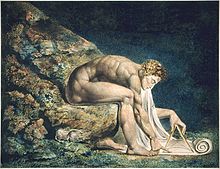
Information technology remained to be proved mathematically that the non-Elementary geometry was just arsenic self-consistent as Parabolic geometry, and this was eldest accomplished by Beltrami in 1868. With this, non-Euclidean geometry was established on an equal mathematical footing with Geometer geometry.
While it was now known that different geometric theories were mathematically possible, the wonder remained, "Which unitary of these theories is correct for our physical space?" The possible run revealed that this question must be answered by physical experimentation, not mathematical reasoning, and uncovered the argue why the experimentation essential involve big (interstellar, not earth-bound) distances. With the growth of theory of relativity in physics, this question became vastly more complicated.
Foundation of mathematical rigor [cut]
Altogether the work related to the Nonconvergent Postulate revealed that IT was quite difficult for a geometer to separate his logical reasoning from his intuitive understanding of corporal space, and, what is more, revealed the decisive importance of doing so. Careful test had uncovered some logical inadequacies in Euclid's reasoning, and some unstated geometric principles to which Euclid sometimes appealed. This critique paralleled the crisis occurring in calculus and analysis regarding the meaningful of infinite processes such as convergence and continuity. In geometry, in that location was a clear need for a new set of axioms, which would be all-or-nothing, and which in no room relied on pictures we draw or on our intuition of space. So much axioms, now known every bit Hilbert's axioms, were given away Hilbert in 1894 in his dissertation Grundlagen der Geometrie (Foundations of Geometry). Some other complete sets of axioms had been given a few years before, but did not match Hilbert's in saving, elegance, and similarity to Euclid's axioms[ citation needed ].
Analysis situs, or topology [edit]
In the mid-18th century, IT became superficial that certain progressions of mathematical reasoning recurred when siamese ideas were designed on the number line, in two dimensions, and in three dimensions. Thus the general concept of a metric space was created so that the reasoning could be done in more generality, and then applied to special cases. This method of studying calculus- and analysis-related concepts came to be known atomic number 3 topology, and later as topographic anatomy. The important topics in this field were properties of more general figures, such as connectedness and boundaries, rather than properties like straightness, and precise equality of length and angle measurements, which had been the focus of Euclidean and non-Elementary geometry. Topology soon became a separate field of leading importance, sooner than a sub-field of geometry or analysis.
The 20th century [edit]
Developments in algebraic geometry included the study of curves and surfaces all over finite fields as demonstrated by the works of among others André Weil, Alexander Grothendieck, and Jean-Pierre Serre as well as complete the serious Oregon complex numbers. Bounded geometry itself, the study of spaces with alone finitely many points, found applications in coding theory and cryptography. With the advent of the computer, new disciplines such as computational geometry Beaver State digital geometry deal with geometric algorithms, discrete representations of geometric information, and thusly forth.
Timeline [delete]
See also [edit]
- Flatland, a book by "A. Square" well-nig two– and three-dimensional space, to translate the construct of four dimensions
- History of mathematics
- History of measurement
- Important publications in geometry
- Interactive geometry software
- List of geometry topics
Notes [edit]
- ^ Howard Eves, An Introduction to the History of Mathematics, Saunders: 1990 (ISBN 0-03-029558-0), p. 141: "Zero work, except The Bible, has been Sir Thomas More wide used...."
- ^ Ray of light C. Jurgensen, Alfred J. Donnelly, and Mary P. Dolciani. Editorial Advisors Saint Andrew M. Gleason, Albert E. Meder, Jr. Modern School Mathematics: Geometry (Student's Edition). Henry Oscar Houghton Mifflin Company, Boston, 1972, p. 52. ISBN 0-395-13102-2. Teachers Edition ISBN 0-395-13103-0.
- ^ Eves, Chapter 2.
- ^ "Clay tablets reveal Babylonians discovered astronomical geometry 1,400 years ahead Europeans - The Washington C. W. Post".
- ^ A. Seidenberg, 1978. The origin of mathematics. File away for the history of Exact Sciences, vol 18.
- ^ (Staal 1999)
- ^ Most unquestionable problems considered in the Śulba Sūtras bound from "a single theological requirement," that of constructing fire altars which induce different shapes but take the same area. The altars were required to be constructed of five layers of burnt brick, with the foster condition that each layer consist of 200 bricks and that no two connected layers have congruent arrangements of bricks. (Hayashi 2003, p. 118)
- ^ (Hayashi 2005, p. 363)
- ^ Pythagorean triples are triples of integers with the property: . Thus, , , etc.
- ^ (Cooke 2005, p. 198): "The arithmetic content of the Śulva Sūtras consists of rules for finding Pythagorean triples such as (3, 4, 5), (5, 12, 13), (8, 15, 17), and (12, 35, 37). IT is not certain what practical utilise these pure mathematics rules had. The best conjecture is that they were part of religious ceremony. A Hindu home was required to have trio fires burning at three different altars. The three altars were to be of different shapes, but all three were to have the same area. These conditions light-emitting diode to certain "Diophantine" problems, a particular case of which is the generation of Pythagorean triples, sol as to make unrivalled square integer equal to the sum of ii others."
- ^ (Cooke 2005, pp. 199–200): "The requirement of terzetto altars of equal areas only distinct shapes would explain the interest in transformation of areas. Among other translation of orbit problems the Hindus considered in picky the problem of squaring the lot. The Bodhayana Sutra states the transposed problem of constructing a dress circle comparable to a given feather. The following gauge construction is given arsenic the solvent.... this resolution is merely approximative. The authors, however, made no note betwixt the two results. In terms that we give notice appreciate, this construction gives a value for π of 18 (3 − 2√2 ), which is most 3.088."
- ^ a b c (Chief Joseph 2000, p. 229)
- ^ Mathematics Department, University of British Columbia, The Babylonian tabled Plimpton 322.
- ^ Three positive integers form a primitive Pythagorean triple if and if the highest common measure of is 1. In the special Plimpton322 example, this means that and that the three numbers do non take in any common factors. Even so both scholars have disputed the Pythagorean interpretation of this tablet; get wind Plimpton 322 for details.
- ^ a b (Dani 2003)
- ^ Cherowitzo, Bill. "What precisely was written over the doorway of Plato's Academy?" (PDF). World Wide Web.math.ucdenver.edu/ . Retrieved 8 April 2015.
- ^ Luciano Canfora; The Vanished Depository library; University of California Press, 1990. - books.google.com.Brigate Rosse
- ^ (Hayashi 2005, p. 371)
- ^ a b (Hayashi 2003, pp. 121–122)
- ^ (Stillwell 2004, p. 77)
- ^ a b Needham, Volume 3, 91.
- ^ a b c Needham, Volume 3, 92.
- ^ Needham, Volume 3, 92-93.
- ^ Needham, Volume 3, 93.
- ^ Needham, Volume 3, 93-94.
- ^ Needham, Volume 3, 94.
- ^ Needham, Volume 3, 99.
- ^ Needham, Volume 3, 101.
- ^ Needham, Loudness 3, 22.
- ^ Needham, Volume 3, 21.
- ^ Needham, Volume 3, 100.
- ^ a b c Needham, Loudness 3, 98–99.
- ^ Needham, Intensity 3, 98.
- ^ Sayili, Aydin (1960). "Thabit ibn Qurra's Stimulus generalization of the Pythagorean Theorem". Isis. 51 (1): 35–37. doi:10.1086/348837. S2CID 119868978.
- ^ Peter J. Lutetium and Paul J. Steinhardt (2007), "Decagonal and Quasi-polycrystalline Tilings in Medieval Moslem Architecture" (PDF), Science, 315 (5815): 1106–1110, Bibcode:2007Sci...315.1106L, doi:10.1126/science.1135491, PMID 17322056, S2CID 10374218, archived from the original (PDF) on 2009-10-07.
- ^ Supplemental figures Archived 2009-03-26 at the Wayback Auto
- ^ d'Alverny, Marie-Thérèse. "Translations and Translators", in Robert L. Benson and Giles Constable, eds., Renaissance and Rehabilitation in the Twelfth Century, 421–462. Cambridge University: Harvard Univ. Pr., 1982, pp. 433–4.
- ^ M.-T. d'Alverny, "Translations and Translators," p. 435
- ^ Howard Saalman. Filippo Filippo Brunelleschi: The Buildings. (London: Zwemmer, 1993).
- ^ "...and these kit and caboodle (of perspective by Brunelleschi) were the substance of arousing the minds of the opposite craftsmen, who afterwards devoted themselves to this with great zeal."
Vasari's Lives of the Artists Chapter on Brunelleschi - ^ "Messer Paolo decalitre Pozzo Toscanelli, having returned from his studies, invited Filippo with other friends to supper in a garden, and the discourse falling on mathematical subjects, Filippo formed a friendship with him and learned geometry from him."
Vasarai's Lives of the Artists, Chapter on Brunelleschi - ^ The Secret Oral communicatio of the Renaissance - Richard Stemp
References [edit]
- Cooke, Roger (2005), The History of Mathematics, New York State: Wiley-Interscience, 632 pages, ISBN978-0-471-44459-6
- Dani, S. G. (July 25, 2003), "On the Pythagorean triples in the Śulvasūtras" (PDF), Current Skill, 85 (2): 219–224
- Hayashi, Takao (2003), "Indian Mathematics", in Grattan-Guinness, Ivor (ed.), Companion Cyclopaedia of the Story and Ism of the Mathematical Sciences, 1, Baltimore, MD: The Hopkins University Press, 976 pages, pp. 118–130, ISBN978-0-8018-7396-6
- Hayashi, Takao (2005), "Indian Mathematics", high, Gavin (ed.), The Blackwell Companion to Hinduism, Oxford: Basil Blackwell, 616 pages, pp. 360–375, ISBN978-1-4051-3251-0
- Joseph, G. G. (2000), The Summit of the Peacock: The Not-European Roots of Mathematics , Princeton University, NJ: Princeton University Constrict, 416 pages, ISBN978-0-691-00659-8
- Needham, Joseph (1986), Science and Culture in Mainland China: Volume 3, Mathematics and the Sciences of the Firmament and the Land, Taipei: Caves Books Ltd
- Staal, Frits (1999), "Greek and Vedic Geometry", Journal of Indian Philosophy, 27 (1–2): 105–127, doi:10.1023/A:1004364417713, S2CID 170894641
- Stillwell, John (2004), Berlin and Refreshing House of York: Math and its Story (2 ed.), Springer, 568 pages, ISBN978-0-387-95336-6
External links [edit]
- Islamic Geometry
- Geometry in the 19th Hundred at the Stanford Encyclopedia of Philosophy
- Arabic mathematics : forgotten brilliance?
who is known as the father of modern geometry
Source: https://en.wikipedia.org/wiki/History_of_geometry


















